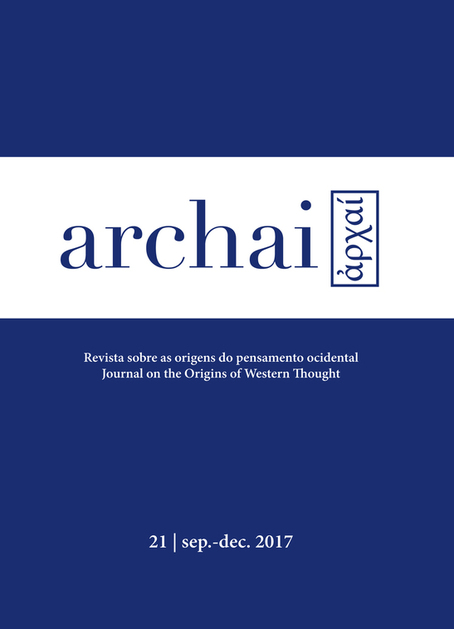On φÏσις. What did the Greeks understand by φυσικός?
DOI:
https://doi.org/10.14195/1984-249X_21_2Keywords:
Philosophical vocabulary, Greek philosophy, Physikos, NatureAbstract
The uses of φυσικός from its former occurrences until the III BC. are examined. After an analysis of the first instances of the term, its uses may be classified into two large groups. In the former, φυσικός can be understood as “natural” or “innate” and various sections can be identified: a) applied to objects or beings, as opposed to ‘artificial’, b) to refer to “natural structures”, c) to qualify properties in the ‘inherent’ sense, d) to attribute to productions and effects of natural activity, in the sense that nature is an active and conscious principle, e) to define capacities, abilities or instincts as opposites to ‘learned’, f) to distinguish activities, behaviours and relationships which they are the result of the customs, g) to apply to laws and justice, as opposed to ‘conventional’, h) with the idea of ‘appropriate’, ‘characteristic’ and (i) opposed to ‘psychic’. The second group includes the uses in which φυσικός is understood as ‘referring to nature as object of study’
Downloads
References
AMMAN, A. (1953). -ikos bei Platon, Ableitung und Bedeutung. Diss. Bern.
BEEKES, R. (2010). Etymological Dictionary of Greek. Leiden-Boston, Brill.
BERNABÉ, A. (2004). “Las ciencias naturales: Aristóteles y el nacimiento de un método”, en J. L. Arcaz Pozo y M. Montero (eds.), Hombre y naturaleza. El nacimiento de la ciencia y la técnica en el Mundo Clásico. Madrid, Delegación de Madrid de la Sociedad Española de Estudios Clásicos, 11-30).
GEMELLI MARCIANO, M. L. (2007-2010). Die Vorsokratiker, I-III, Berlin, Akademie Verlag.
GIGANTE, M. (1964). “Parmenide Uliade,” PP 19, 450 - 452.
JOHNSON, M. R. (2005). Aristotle on Teleology. Oxford, Oxford University Press.
PERILLI, L. - TAORMINA, D. P. (2012). La filosofia antica. Itinerario storico e testuale. Novara, UTET.
URMSON, J. O. (1990). The Greek Philosophical Vocabulary. London, Duckworth.
Downloads
Published
How to Cite
Issue
Section
License
Given the public access policy of the journal, the use of the published texts is free, with the obligation of recognizing the original authorship and the first publication in this journal. The authors of the published contributions are entirely and exclusively responsible for their contents.
1. The authors authorize the publication of the article in this journal.
2. The authors guarantee that the contribution is original, and take full responsibility for its content in case of impugnation by third parties.
3. The authors guarantee that the contribution is not under evaluation in another journal.
4. The authors keep the copyright and convey to the journal the right of first publication, the work being licensed under a Creative Commons Attribution License-BY.
5. The authors are allowed and stimulated to publicize and distribute their work on-line after the publication in the journal.
6. The authors of the approved works authorize the journal to distribute their content, after publication, for reproduction in content indexes, virtual libraries and similars.
7. The editors reserve the right to make adjustments to the text and to adequate the article to the editorial rules of the journal.



